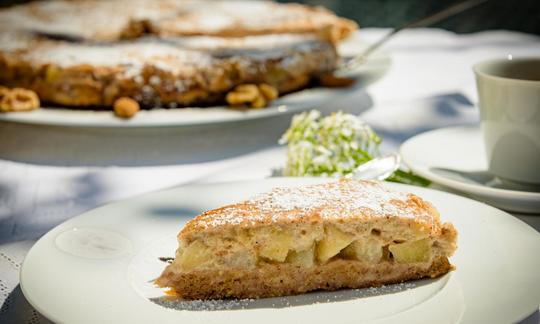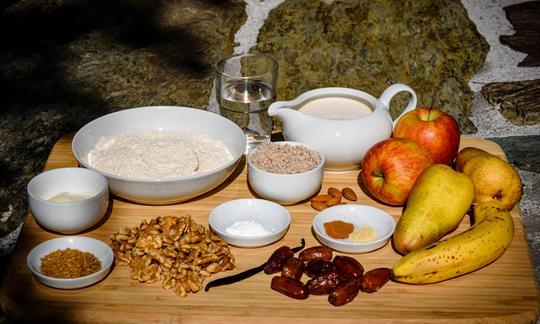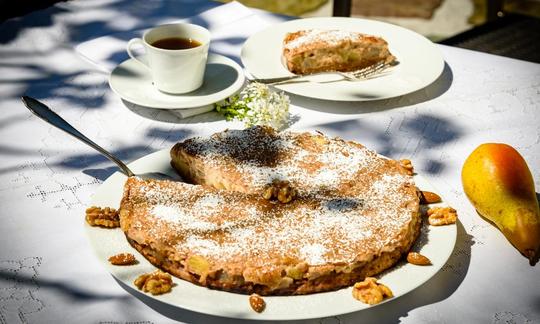Pear-Apple Pie with Semolina Filling and Almond Pomace
vegan
Ingredients (for servings, )
| For the almond milk | |
|---|---|
| 3 ½ oz | Almonds (sweet almonds), raw |
| 600 ml | Drinking water, raw (organic?) (21 oz) |
| For the floor | |
| 1 ¾ oz | Walnuts (tree nuts), raw (organic?) |
| 1 tbsp, ground | Linseed, raw, organic? (golden linseed, flax) (0.25 oz) |
| 4 | Dates, Medjool variety, pitted, raw? (organic?) (3.4 oz) |
| ½ | Bananas, raw (organic?) (2.1 oz) |
| 5 ½ oz | Wheat flour, wholemeal (organic?) |
| 1 tsp | Cream of tartar baking powder (raising agent, organic?) (0.11 oz) |
| 1 dash | Table salt (table salt, raw?, organic?) (0.01 oz) |
| 120 ml | Drinking water, raw (organic?) (4.2 oz) |
| For the fruit filling | |
| 2 | Apples, raw, without peel (organic?) (11 oz) |
| 2 large | Pears, raw (organic?) (16 oz) |
| For the semolina porridge | |
| 6 | Dates, Medjool variety, pitted, raw? (organic?) (5.1 oz) |
| 1 ¼ oz | Soft wheat semolina (raw, organic?) |
| ½ | Vanilla pod (also Bourbon vanilla, organic?) (0.05 oz) |
| ½ tsp | Cinnamon (ground, raw, organic?) (0.05 oz) |
| ½ tsp | Lemon peel, raw (organic?) (0.04 oz) |
| For decoration | |
| ¼ cup, chopped | Walnuts (tree nuts), raw (organic?) (1.0 oz) |
Equipment
- blender
- hand-held blender / immersion blender
- nut milk bag
- vegetable peeler
- baking pan (springform pan)
- stove
- refrigerator
- saucepan
- oven
- sieve
- Topfhandschuh, Topflappen
- shredder
Type of preparation
- cook
- bake
- chop or grind
- soak
- blend
- squeeze
- cool
- purée
- peel
- sift
- drain
- knead
Preparation
For the almond milk (prepare the day before)
Soak the almonds in water for 8-12 hours. Drain the water and rinse the almonds well. Put the almonds in a strong blender with a little water. After the first blend, add the remaining water and blend to a smooth "milk".Press the nut milk through a nut milk bag or clean tea towel and collect the almond milk. Set aside both the almond milk and the almond pulp (the latter is part of the tart base, step 3).
For the floor
Process the walnuts, linseed, dates and banana in a food processor to form a paste. Process the mixture into a dough with the wholemeal flour, almond pulp (from step 2), baking powder, salt and water.Adjust the amount of water to create a fairly firm to viscous dough.
Instead of cream of tartar you can also use baking powder, the effect is the same.
Put the dough into a springform pan (Ø 26 cm) lined with baking paper and bake in a preheated oven at 180 °C for about 10 minutes. Then remove and set aside.
In the meantime, you can prepare the fruit (step 5).
For the fruit (fruit filling)
Peel and core the apples and pears and cut them into small pieces. Simmer in a pan with a little water (just enough so that it doesn't burn) for 3 minutes (the fruit should be slightly soft but not cooked). Then remove from the heat and set aside.For the semolina porridge
Puree the dates with a little almond milk using a hand blender. Then put them in a pot with the remaining almond milk and the semolina. Scrape the vanilla pulp out of the pod with the tip of a knife and add it together with the cinnamon and lemon peel. Cook for about 5 minutes, stirring, until you get a semolina porridge (it's okay if it's still runny).If you don't have vanilla pulp, you can also usevanilla powder or vanilla extract.
Finishing the cake
Spread the fruit (from step 5) on the cake. Chop the walnuts and sprinkle them on top. Pour the semolina pudding on the cake as the last layer.
Bake the cake for about 20 minutes at 180 °C.The cake should only have a light brown color, but not appear dark brown.
Remove the cake from the oven, let it cool and chill in the fridge.
Cut and enjoy!
Decorate with powdered sugar if necessary.
|
Nutritional Information per person
Convert per 100g
|
2000 kcal | |
|---|---|---|
| Energy | 292 kcal | 14.6% |
| Fat/Lipids | 11 g | 15.8% |
| Saturated Fats | 0.99 g | 4.9% |
| Carbohydrates (inc.dietary fiber) | 48 g | 17.6% |
| Sugars | 25 g | 28.0% |
| Fiber | 7.4 g | 29.7% |
| Protein/Albumin | 6.6 g | 13.1% |
| Cooking Salt (Na:41.0 mg) | 104 mg | 4.3% |
| Essential micronutrients with the highest proportions | per person | 2000 kcal | |
|---|---|---|---|
| Min | Manganese, Mn | 1.3 mg | 65.0% |
| Min | Copper, Cu | 0.45 mg | 45.0% |
| Fat | Alpha-Linolenic acid; ALA; 18:3 omega-3 | 0.90 g | 45.0% |
| Fat | Linoleic acid; LA; 18:2 omega-6 | 4.5 g | 45.0% |
| Prot | Tryptophan (Trp, W) | 0.07 g | 29.0% |
| Elem | Magnesium, Mg | 84 mg | 23.0% |
| Elem | Phosphorus, P | 164 mg | 23.0% |
| Vit | Vitamin E, as a-TEs | 2.8 mg | 23.0% |
| Elem | Potassium, K | 447 mg | 22.0% |
| Prot | Threonine (Thr, T) | 0.20 g | 21.0% |
Detailed Nutritional Information per Person for this Recipe
The majority of the nutritional information comes from the USDA (US Department of Agriculture). This means that the information for natural products is often incomplete or only given within broader categories, whereas in most cases products made from these have more complete information displayed.
If we take flaxseed, for example, the important essential amino acid ALA (omega-3) is only included in an overarching category whereas for flaxseed oil ALA is listed specifically. In time, we will be able to change this, but it will require a lot of work. An “i” appears behind ingredients that have been adjusted and an explanation appears when you hover over this symbol.
For Erb Muesli, the original calculations resulted in 48 % of the daily requirement of ALA — but with the correction, we see that the muesli actually covers >100 % of the necessary recommendation for the omega-3 fatty acid ALA. Our goal is to eventually be able to compare the nutritional value of our recipes with those that are used in conventional western lifestyles.
| Essential fatty acids | per person | 2000 kcal |
|---|---|---|
| Alpha-Linolenic acid; ALA; 18:3 omega-3 | 0.90 g | 45.0% |
| Linoleic acid; LA; 18:2 omega-6 | 4.5 g | 45.0% |
| Essential amino acids | per person | 2000 kcal |
|---|---|---|
| Tryptophan (Trp, W) | 0.07 g | 29.0% |
| Threonine (Thr, T) | 0.20 g | 21.0% |
| Phenylalanine (Phe, F) | 0.32 g | 21.0% |
| Isoleucine (Ile, I) | 0.23 g | 19.0% |
| Leucine (Leu, L) | 0.44 g | 18.0% |
| Valine (Val, V) | 0.28 g | 18.0% |
| Lysine (Lys, K) | 0.19 g | 10.0% |
| Methionine (Met, M) | 0.08 g | 9.0% |
| Vitamins | per person | 2000 kcal |
|---|---|---|
| Vitamin E, as a-TEs | 2.8 mg | 23.0% |
| Vitamin B6 (pyridoxine) | 0.23 mg | 17.0% |
| Thiamine (vitamin B1) | 0.17 mg | 15.0% |
| Folate, as the active form of folic acid (née vitamin B9 and | 30 µg | 15.0% |
| Riboflavin (vitamin B2) | 0.19 mg | 14.0% |
| Niacin (née vitamin B3) | 1.9 mg | 12.0% |
| Biotin (ex vitamin B7, H) | 4.5 µg | 9.0% |
| Pantothenic acid (vitamin B5) | 0.47 mg | 8.0% |
| Vitamin C (ascorbic acid) | 4.0 mg | 5.0% |
| Vitamin K | 3.5 µg | 5.0% |
| Vitamin A, as RAE | 3.1 µg | < 0.1% |
| Essential macroelements (macronutrients) | per person | 2000 kcal |
|---|---|---|
| Magnesium, Mg | 84 mg | 23.0% |
| Phosphorus, P | 164 mg | 23.0% |
| Potassium, K | 447 mg | 22.0% |
| Calcium, Ca | 70 mg | 9.0% |
| Sodium, Na | 41 mg | 5.0% |
| Essential trace elements (micronutrients) | per person | 2000 kcal |
|---|---|---|
| Manganese, Mn | 1.3 mg | 65.0% |
| Copper, Cu | 0.45 mg | 45.0% |
| Selenium, Se | 10 µg | 19.0% |
| Iron, Fe | 1.6 mg | 12.0% |
| Zinc, Zn | 1.2 mg | 12.0% |
| Fluorine, F | 52 µg | 1.0% |
| Iod, I (Jod, J) | 0.38 µg | < 0.1% |
The pear and apple tart with semolina filling, walnuts and almond pomace contains no sugar or added fats.
Nutrient profile: According to GDA guidelines, one portion covers more than half of the average daily requirement of manganese and almost 50% of that of copper and the two essential fatty acids. Magnesium, phosphorus, vitamin K and potassium are covered by about ¼. The ratio of omega-6 to omega-3 fatty acids is 5:1, which is within the maximum recommended ratio.
Apples: Apples contain a high proportion of water/juice and a large proportion of fiber. There is a kind of "daily recipe" for apples with more information at the following link: The daily apple: An apple a day keeps the doctor away. The daily apple is found - not as a whole apple in the same quantity - in Erb muesli, and also in the original Bircher muesli by Dr. med. Max Bircher-Benner.
Pears: Pears ( Pyrus communis) contain, among other things, small amounts of folic acid, copper, vitamin C, potassium and vitamin K. Thanks to their low acid content, they are easier to digest than apples and, like apples, stimulate digestion.
Dates: The date fruit with its honey-like sweet taste is actually a berry fruit. It is rich in vitamin B6 and the minerals copper and potassium. It also contains more fiber than conventional wholemeal bread. When ripe, Medjool dates often have a softer consistency than other types of dates, which is why they are ideal for this purpose.
Wholemeal flour: Wholemeal is grain from which only the awns and husks have been removed after harvest. Dietary fiber, vitamins, oils and minerals remain in the shell and the germ. The oils are particularly valuable from a nutritional point of view because they have a high content of essential fatty acids.
Semolina: Semolina is made from grains, usually durum or soft wheat, using a rather complex process. The degree of milling allows a finer division according to grain size. Soft wheat semolina is mainly used for fine desserts, while durum wheat semolina is mainly used for hearty dishes such as semolina dumplings.
Almonds: Almonds have a good ratio of high fat content of 49%: only 7.4% of which is saturated fat and no trans fats and are a good source of iron. However, they have a very poor ratio of linoleic acid (LA) to alpha-linolenic acid (ALA).
Walnut: The real walnut, also called tree nut, has the highest content of linolenic acid (an omega-3 fatty acid that is healthy for the heart) of all nuts. They are also rich in vitamin E, zinc (an important trace element for the liver and hair, among other things) and potassium.
Preparations the day before: In order to invest as little time as possible in the actual preparation, it is worth either preparing the almond milk and the pulp the day before and storing it in the fridge, or at least soaking the almonds overnight. Almond milk should last for four days in the fridge in an airtight container. Shaking will bring the settled part back together.
Soaking almonds: Soaking almonds not only changes their consistency, but also reduces the amount of phytic acid. This forms solid complexes with certain food substances such as minerals and thus limits their absorption by the body. You can find a corresponding article on this at the following link:
Phytic acid or phytate and soaking or sprouting.
What do you have to watch out for as a vegan? In the nutrient tables under the recipe preparation you will find more information about the composition of this dish. Information on the optimal ratio of essential fatty acids ( linoleic acid to alpha-linolenic acid) and general information on common nutritional errors in vegan and raw diets can be found at the following link: Vegans often eat unhealthily. Avoidable nutritional errors.
Storage of pears and apples: Apples are climacteric fruits, which means they continue to ripen after harvest. In doing so, they emit the gaseous plant hormone ethylene. If you put an apple under a cover next to other unripe fruits, the gas emitted by the apple will ensure that they ripen more quickly. Fruit and vegetables that are sensitive to ethylene include pears, broccoli, cauliflower, cucumbers and tomatoes.
A sealable polyethylene (PET) foil bag with small air holes is ideal for storing whole apples. Ripe pears should only be stored at room temperature for a few days. The pressure-sensitive fruit is best stored in a dry refrigerator.
Optimal springform pan size: A springform pan with a diameter of approx. 26 cm is best suited for the amount we have designed for 10 portions.
Baking powder: Instead of cream of tartar, you can also use baking powder, as everyone probably has this on hand. The effect is the same. The difference is that cream of tartar does not contain phosphate. It is made from cream of tartar (also called tartaric acid) with the addition of sodium bicarbonate. Cream of tartar crystallizes at the bottom when wine and grape juice are stored in barrels.
Separate recipe for almond milk: If you would like more information about almond milk, or plan to print or view it as a separate recipe, you can use the following link: Unsweetened almond milk as a raw food: naturally vegan. Of course, you are free to use cashew milk, soy milk or another plant-based drink as an alternative.
Types of dates: Many other types are suitable instead of Medjool dates. Just make sure that the weight ratio of the pitted dates remains the same.
Wholemeal spelt flour instead of wholemeal wheat flour: You can just as easily replace the wholemeal wheat flour listed here with wholemeal spelt flour. Unlike wheat flour, this has a significantly higher silica content. Although it contains gluten, there are some people with gluten intolerance who can use it without any problems. The basis for this phenomenon is still unknown, so there is still a need for research in this area.
Sweetness: If this dish is not sweet enough for you, you can slightly increase the amount of dates. The type of apple also influences the sweetness.








